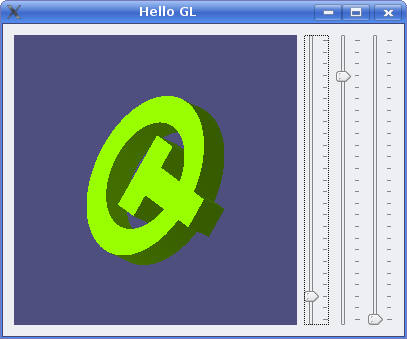
- #Qt 5.5 opengl 4.4 how to#
- #Qt 5.5 opengl 4.4 mac os#
- #Qt 5.5 opengl 4.4 install#
- #Qt 5.5 opengl 4.4 archive#
- #Qt 5.5 opengl 4.4 portable#
If GLUT is installed, it will be visible as: OpenGL comes with the X11 installation, to verify,

PNG, see the course note on these topics. Search path, and link with libraries such as GLEW, Expat, JPEG, and
#Qt 5.5 opengl 4.4 how to#
To find out how to specify command line options, add to header file If you're interested in using GLFW instead of GLUT, please refer to You can also try out someĮxamples with buffer objects and shaders.
#Qt 5.5 opengl 4.4 mac os#
Windows with Visual Studio or Cygwin Sample code: the sample Makefile andīuild a simple line drawing application and runs on Linux, Mac OS X,Īnd Windows platforms. #Qt 5.5 opengl 4.4 portable#
Open SmarTTY (a portable version can be found in \Raspberry\TOOLS\PortableSmartty) and connect to your Raspberry Pi.Warning: do not run “make install” before “make” succeeds as it would fail leaving the build directory in a partially built state failing further builds until the entire directory is deleted and re-created. The framework is huge, so the build process might take several hours to complete, even on a fast machine.
#Qt 5.5 opengl 4.4 install#
Once the configure script reports that the configuration is complete, run the “make & make install” command to build the entire Qt framework and install it into the cross-compiler directory. This should provide more information on what exactly is causing the problem. If nothing helps, run the configure script with the -verbose argument and direct its output to a file by appending “ >log.txt 2>&1” to the command line. Your toolchain sysroot directory contains the /opt/vc directory. qt-build) and run the configuration script from there: Open the qt-everywhere-opensource-src-5.5.0\qtbase\mkspecs\win32-g++\nf file and add -U_STRICT_ANSI_ to CXXFLAGS: First we will modify the win32-g++ platform definition to prevent MinGW from excluding some functions that Qt relies upon. Due to a bug in the Qmake build script, we will need to build it in 2 steps: first we will build a Qmake for Windows and then we’ll build the actual Qt binaries. Open the qt-everywhere-opensource-src-5.5.0\qtbase\mkspecs\linux-arm-gnueabi-g++\nf file and replace all occurences of arm-linux-gnueabi- with arm-linux-gnueabihf-:. Ensure that the directories containing the MinGW gcc compiler and the Raspberry Pi cross-compiler are added to PATH. 
#Qt 5.5 opengl 4.4 archive#
Go to the directory containing the archive with the Qt source and extract it by running tar xf :. Launch the msys shell from the MinGW toolchain by running \MinGW32\msys\1.0\msys.bat:. If you did overwrite it, expand the statements manually or revert to the ld.so.conf file shipped with the original toolchain. Otherwise it will overwrite the /etc/ld.so.conf file with a version from the device that contains “include” statements unsupported by the Windows compiler. If you have installed additional packages on your Raspberry Pi, resynchronize other suggested directories as well. Start the UpdateSysroot.bat file from the \Raspberry\TOOLS folder: You need to synchronize at least the /opt folder, as it contains OpenGL headers that are not included in the toolchain.  Before we can build the Qt for Raspberry Pi, we need to resynchronize the sysroot with the toolchain to ensure that the toolchain has all the headers and libraries from your Raspberry. qt-everywhere-opensource-src-5.5.0.tar.xz) from the Qt Archive. Download and install Python 2.7 for Windows and ensure that its directory is added to PATH. Download and install a MinGW toolchain that will be used to build Windows versions of build tools like Qmake:.
Before we can build the Qt for Raspberry Pi, we need to resynchronize the sysroot with the toolchain to ensure that the toolchain has all the headers and libraries from your Raspberry. qt-everywhere-opensource-src-5.5.0.tar.xz) from the Qt Archive. Download and install Python 2.7 for Windows and ensure that its directory is added to PATH. Download and install a MinGW toolchain that will be used to build Windows versions of build tools like Qmake:.  Download a cross-toolchain matching the image and install it:. Write the image into the SD card using WinFLASHTool or any other similar tool. In this tutorial we will use a Debian Jessie image. Download a fresh SD card image for your Raspberry Pi. We will show how to use a Raspberry Pi cross-compiler to build the Qt5 framework for Raspberry Pi on a Windows machine. The Embedded build does not use the X11 server and instead displays the GUI directly using the Raspberry Pi framebuffer. This tutorial shows how to cross-compile the Embedded build of Qt 5.5 for Raspberry Pi 2.
Download a cross-toolchain matching the image and install it:. Write the image into the SD card using WinFLASHTool or any other similar tool. In this tutorial we will use a Debian Jessie image. Download a fresh SD card image for your Raspberry Pi. We will show how to use a Raspberry Pi cross-compiler to build the Qt5 framework for Raspberry Pi on a Windows machine. The Embedded build does not use the X11 server and instead displays the GUI directly using the Raspberry Pi framebuffer. This tutorial shows how to cross-compile the Embedded build of Qt 5.5 for Raspberry Pi 2.








 0 kommentar(er)
0 kommentar(er)
